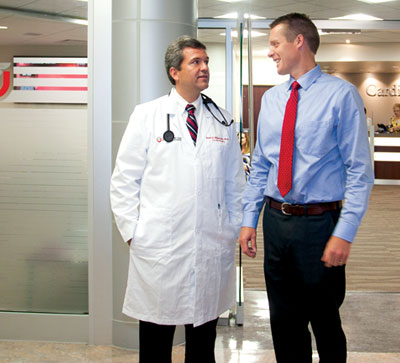Streamlining Care

“If our patients need a navigator, then we haven’t designed a system that works.” That’s how David Entwistle, M.H.A., CEO of University of Utah Hospitals and Clinics, sees our current health care delivery system. While patient navigators can be invaluable in today’s world, their very existence highlights how broken health care really is.
We may pay a lot for health care in this country – $2.8 trillion, by last count – but at least we can count on a doctor being able to see us in a pinch, right? This may be what we tell ourselves, that we pay for what we get: efficient, top quality care. But the truth is less flattering. Patients in this country wait an average of 20 days to see a primary care physician, 29 days to see a dermatologist, and six months to see some sub-specialists. Once in the system, they meet with further, sometimes harmful, delays, which too often trace back to poor communication: lost paperwork, duplicate tests or long waits to be admitted, transferred, prepped and discharged. According to the Joint Commission’s Center for Transforming Healthcare, about 80 percent of serious medical errors happen because of miscommunication when patients are handed off from one provider or care center to another. Every week, there are up to 40 wrong-patient, wrong-procedure, wrong-site and wrong-side surgeries.
Here’s the thing: If we don’t get it right soon, how will we handle the influx of an estimated 32 million newly insured patients as a result of the Affordable Care Act?

“Every system is perfectly designed to achieve exactly the results it gets,” says Donald Berwick, M.D., former administrator of the Centers for Medicare and Medicaid Services. In the case of academic medicine, we’ve built our system around providing highly specialized care to patients. From that viewpoint, we’ve produced spectacular results. “The model we’re trained in is an army of one,” says Chief Medical Officer Thomas Miller, M.D. “We’re operating little islands. You come to my island and get coconuts, go to the other islands to get mangos. The system’s not set up so that we’re paid or aligned or incentivized to collaborate, and that shows in the way we see patients.”
Entwistle admits that trying to fix health care can often seem like trying to turn the Titanic, especially when many of the best ideas to streamline care are not reimbursable or apply to patients outside our reach. The complexity of the patients in academic medicine multiply our challenges. There are a thousand points of variation and an equal number of opportunities to get it wrong. One thing is certain. We can’t solve everything at once. There is no silver bullet. No one master plan.
Management consultant and author Adrian Slywotzky, J.D., M.B.A., recommends we start by creating a hassle map – identifying all of the irritations, frustrations and delays – first from the patient’s experience and then from all of the stakeholders’ perspectives and then work our way backward to fix them one by one. “We need to find the confluence of convenience and ease and value for patients and providers alike,” says Michael Magill, M.D., chair of family and preventive medicine.
Hassle maps look different from different perspectives. Part of creating sustainable solutions is to address everyone’s. That means including important voices in the conversation that traditionally have been excluded, primarily the patient’s, but also those who work in environmental services, transport, social work and case management. “We have incredibly bright people who haven’t been told the whole story,” says Tracey Nixon, R.N., nursing director of capacity management. “When we’re only able to see the patient through our unique angle, it makes figuring out flow very difficult.” Instead, the tendency is to finger point or create workarounds that shift responsibility to someone else. Nixon believes that if people had a better sense of the whole picture, they’d be invested in figuring out ways to move the patient throughout the whole system and not just through their piece of it. It makes everyone’s lives easier.
Times are changing. In academic medicine, we’re finally starting to think about our patients’ health more holistically and, to Berwick’s point, we need to create a new system that will produce results to match that vision. “We want to be lifelong partners with our patients and our communities, and that requires integration across all of our specialties,” says CEO of University of Utah Health Care Vivian S. Lee, M.D., Ph.D., M.B.A. “We’re thinking about the whole continuum of care – from primary to secondary to tertiary care, from rehab to recovery, from wellness to chronic care.” It’s a long process, says Lee, one that requires us to define our goals more clearly and find ways to engage everyone in working towards them.
“We need to communicate the vision and the context to people and then inspire people to believe that they can do great things,” says Robert Pendleton, M.D., chief quality officer, who adds that he sees kernels of magnificence happening all over. By many metrics, University of Utah Health Care is a highly functioning system. For four years running, University HealthSystems Consortium (UHC) has ranked us in the top 10 for quality, and according to Press Ganey rankings we’re leading the country in physician satisfaction for outpatient care. Part of our success flows from being transparent and honest about our weaknesses. We were the first academic medical center in the country to post patient reviews online, both positive and negative.
Even still, Entwistle is quick to point out, there’s room to improve. “When we were awarded No. 1 in quality by UHC, our score was 68.4 out of 100,” says Entwistle. “You can’t ever think you’ve arrived. You have to be anxious and constantly looking to improve.” Every patient gives us an opportunity to learn and get better at what we do, says Lee. Eventually, we want to turn that hassle map into a value stream. Magill puts it this way. “We want to design a system that wraps our patients in care.” On the following pages, we highlight examples of how we’re working toward that goal.





